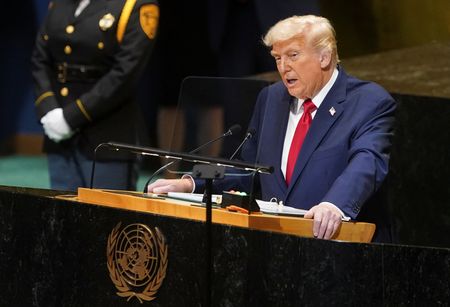By Gergely Szakacs
BUDAPEST (Reuters) -Hungary’s central bank must maintain tight monetary conditions to curb inflation it now sees higher in the 2026 election year partly due to government measures fuelling consumption, it said on Tuesday after leaving its main rate unchanged.
Earlier the bank left its base rate on hold at the European Union’s joint-highest 6.5% level, as widely expected, marking a year-long pause in rate easing amid higher inflation and price risks looming in 2026.
All 20 economists surveyed between September 15 and 18 said the bank would leave its main rate steady, on a par with that of neighbouring Romania, where government tax hikes to curb the EU’s highest budget deficit have triggered a surge in prices.
Hungary’s inflation ran unchanged at an annual 4.2% in August based on Eurostat figures, central Europe’s second-highest rate behind that of Romania, and above the National Bank of Hungary’s 2% to 4% tolerance band.
STRONG CONSUMPTION DRIVING ECONOMIC RECOVERY
“Strong consumption dynamics will remain an important factor of growth over the entire forecast horizon, supported both by rising real wages and government measures,” the Monetary Council said.
“In the baseline scenario, price stability can be achieved in a sustainable manner by ensuring tight monetary conditions.”
The bank sees inflation outside its tolerance band all year, easing to 3.8% in 2026, slightly above its June forecast.
In power since 2010, eurosceptic Prime Minister Viktor Orban faces what political analysts say could be his toughest election next year, with the economy stagnating and stubborn inflation preventing interest rate cuts.
Orban aims to fend off a challenge from a surging opposition rival with large-scale tax cuts for families, cheap loans to first-time home buyers and pension rises.
The central bank said government measures announced over the summer would have a moderate impact on the 2025 budget, which is now seen running a 4.5% shortfall, above earlier plans, but their deficit-increasing impact may grow from 2026.
“While we currently forecast 100bp of cuts in 2026, the risk of fiscal loosening ahead of next year’s parliamentary election means it is highly possible that less monetary easing is delivered,” Capital Economics analyst Nicholas Farr said.
GOVERNOR WELCOMES GAINS IN THE FORINT
The forint scaled a 15-month high last week as it benefited from a higher interest rate differential after the U.S. Federal Reserve cut the cost of borrowing for the first time this year.
It has also benefited from central bank Governor Mihaly Varga saying this month that Hungary should not build an economic strategy on devaluing its currency, which has weakened sharply since 2010.
Varga welcomed the forint’s gains, which could help curb inflation, but with Orban capping food prices and some service sector companies postponing price hikes until after the election, there is a risk of inflation surging again after the vote.
(Additional reporting by Krisztina Than; Writing by Gergely Szakacs; Editing by Bernadette Baum and Alison Williams)










